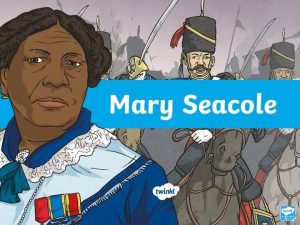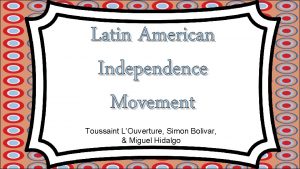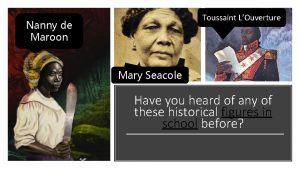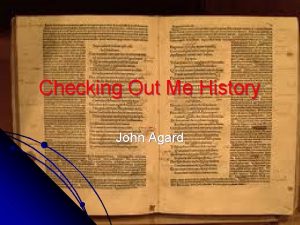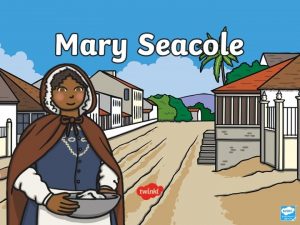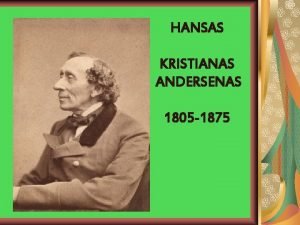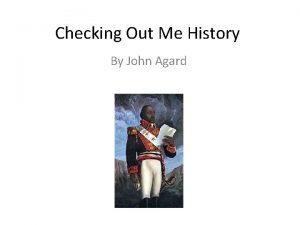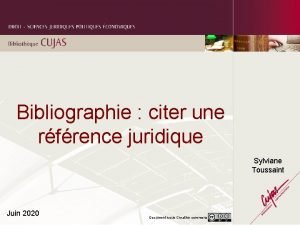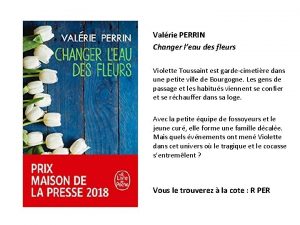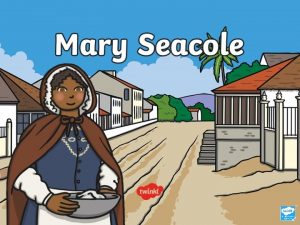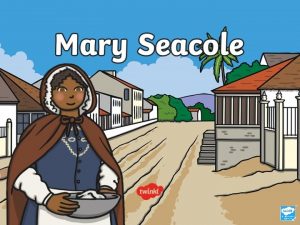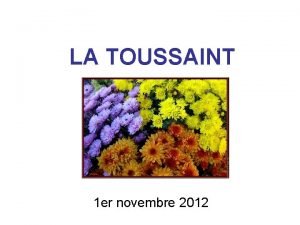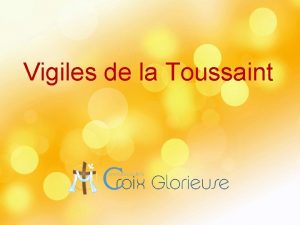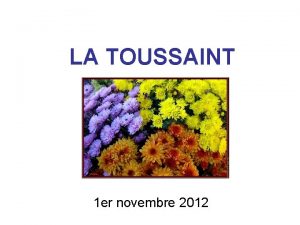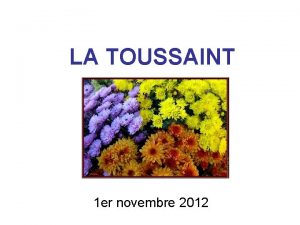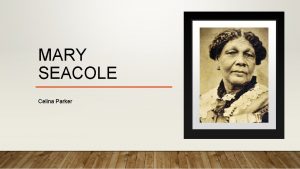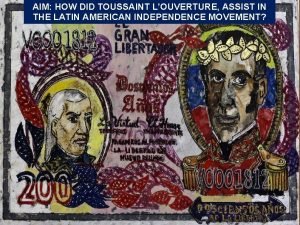Toussaint LOuverture Nanny de Maroon Mary Seacole Have

















- Slides: 17

Toussaint L’Ouverture Nanny de Maroon Mary Seacole Have you heard of any of these historical figures in school before?

Write four facts for each person 1) Toussant Louvertere • He was a slave but he read lots of books as a child to try and educate himself. • He had no military training but he managed to drive Napolean out of Haiti so that it could become an independent country. • He won 7 battles in 7 days. • He managed to stop slavery in all the French colonies.

2) Nanny de Maroon • She was a leader of a group of people in Ghana called the Maroons. • Maroon people were forced to be slaves in Jamaica. • She ran away from a slave plantation and formed her own tribe of Maroon people. • She became a hero because her town of people managed to fight off soldiers that tried to make them slaves. • She saved 1000 slaves because they resettled and were safe with her.

3) Mary Seacole • Her mother was a nurse and she travelled to countries like Haiti building on her medical knowledge. • She came home and demanded that the British War Office send her to the Crimean War. • She gave British soldiers food, water and medical help. • She even risked her life going onto the battlefield to help the soldiers. The British Soldiers nicknamed me ‘Mother Seacole’

AO 3 • John Agard was born in Guyana: a British colony. • At school he was taught a very white-British curriculum. • He moved to Britain when he was around the age of 30. In this poem Agard is criticising how those in power shape what we learn lear and this is wrong. He missed out a huge part of his black identity because he was taught about British white historical figures.

Let’s listen to Agard read the poem out to us.

AO 2 - Structure • Repetition of “dem tell me” at the start of stanzas to emphasise his anger and building frustration. • Lots of short sentences when he talks about what he was taught by the white education system- again shows his anger.

Dem tell me bout 1066 and all dat dem tell me bout Dick Whittington and he cat But Toussaint L’Ouverture no dem never tell me bout dat When he talks about what he was taught by the white education system it is like a song and about silly childish things. Toussaint a slave with vision lick back Napoleon battalion and first Black Republic born Toussaint de thorn to de French Toussaint de beacon of de Haitian Revolution Then when he talks about black important people in history, he speaks properly, it is more serious, more emotional and the italics clearly separate the black and white.

He won’t conform (follow) to Standard English Dem tell me Angry that those in power pick what to teach him. So he missed a part of his identity Wha dem want to tell me Powerful metaphor The English schools blinded him to his own black history. Bandage up me eye with me own history Blind me to me own identity

A children’s story of folklore (passed down by people) about a man who was poor but he got a cat that made him rich Dem tell me bout 1066 and all dat dem tell me bout Dick Whittington and he cat But Toussaint L’Ouverture “and all that” shows how it wasn’t important no dem never tell me bout dat Toussaint a slave with vision lick back Napoleon Toussaint the thornmetaphor shows how he was unstoppable and strong against the French. battalion and first Black Republic born Toussaint de thorn to de French Toussaint de beacon of de Haitian Revolution Toussaint is also called a beacon (light, hope) for starting a revolution freeing those in Haiti who were slaves for the French.

“the man” shows he can’t even remember who. It wasn’t important to him. Dem tell me bout de man who discover de balloon and de cow who jump over de moon Dem tell me bout de dish ran away with de spoon The triplet of rhymes sounds like music. Adds to how childish the white education was. but dem never tell me bout Nanny de maroon Lots of powerful metaphors for Nanny de Maroon Nanny see-far woman of mountain dream fire-woman struggle “fire woman” “mountain dream” “freedom river” hopeful stream to freedom river She gave freedom to slaves who came to her town. Agard uses nature her to show REAL she was compared to the childish pretend characters like the cow and the spoon

Lord Nelson- a British royal navy officer Waterloo- a battle between France and Britain over who owned Belgium “but” shows how annoyed he is Dem tell me bout Lord Nelson and Waterloo but dem never tell me bout Shaka de great Zulu Dem tell me bout Columbus and 1492 but what happen to de Caribs and de Arawaks too Shake de great Zulu and African warrior Notice the adjective “great” for his pride in a black historical figure.

Dem tell me bout Florence Nightingale and she lamp and how Robin Hood used to camp Dem tell me bout ole King Cole was a merry ole soul but dem never tell me bout Mary Seacole She was brave and asked to go to the war to give medical help From Jamaica she travel far to the Crimean War she volunteer to go and even when de British said no she still brave the Russian snow a healing star among the wounded a yellow sunrise to the dying Can you spot some light imagery used to describe Mary Seacole? Where can you also see more words to do with nature?

Possessive pronoun “me” meaning “my” shows he has owns his black history. He owns his indentity. Dem tell me Shows how he has taken control. He hasn’t let his past education control his present. Dem tell me wha dem want to tell me Verb “carving” But now I checking out me own history sounds like a I carving out me identity hard task. He has to work hard to find his black roots.

Checking Out Me History by John Agard Explain the link between the words below and the poem: - Re-appropriation - Marginalised - Self-identification Agard references a book How is the rhyme used within published in 1930 that this poem? parodies history with fictional stories – why might he have done this? “Bandage up me eye with me own history/Blind me to me own/Identity”. What are the connotations of “bandage” and “blind” Why does Agard use intertextual references throughout this poem? Why has the poet decided to write about this subject in non-standard English? How does Agard create his own accent in this poem? How does the poet feel about culture- celebratory or angry? John Agard was born in Guyana, a Caribbean country in South America, but he moved to Britain in 1977. How does this poem reflect this? Is this poem more about power or conflict? Explain. How does the poem’s structure reflect the persona’s pride in history? How does the lack of punctuation allow the reader to reflect on how the speaker feels in English culture? ‘Dem tell me’- Explain the importance of this quotation. Meaning Context Structure Language How many points can you accumulate in twenty minutes? Use short, direct quotations to extend ideas.

You’ve completed your homework! Enjoy these hilarious jokes. A bar was walked into by the passive voice. An oxymoron walked into a bar, and the silence was deafening. Two quotation marks walk into a “bar. ” Hyperbole totally rips into this insane bar and absolutely destroys everything. A question mark walks into a bar? A figure of speech literally walks into a bar and ends up getting figuratively hammered. An allusion walks into a bar, despite the fact that alcohol is its Achilles heel. A simile walks into a bar, as parched as a desert.

Also…Miss Camp recommends READING…. What’s it about? From the writer of ‘Blackadder’, a comic but emotive exploration of WW 1 life from the point of view of a conscientious objector/ detective. A murder mystery unlike any other. Good for…. Developing your understanding about conditions in WW 1, thinking about alternative perspectives to soldiers in wars, seeing how tragedy and comedy can intertwine successfully. What’s it about? Music-obsessed, soul-searching record shop worker living in Camden revisits each failed relationship he’s had in an attempt to root out the source of his unhappiness/ happiness. Sarcastic, well written and surprisingly gripping. Good for…. Your i. Tunes library, your vocabulary bank and curbing any unrealistic expectations you might have of love or life. What’s it about? A ludicrous, ambitious and hilarious flashforward into a future where Hitler somehow wakes up and stumbles into a You. Tube cult celebrity fame. Good for…. Developing your knowledge about WW 2, understanding how surreal fiction can be successful, thinking about a distinctive and unusual narrative “voice”.
 What was mary seacole famous for
What was mary seacole famous for Toussaint louverture simon bolivar
Toussaint louverture simon bolivar Father hidalgo
Father hidalgo Facts about nanny de maroon
Facts about nanny de maroon Checking out me history poem
Checking out me history poem Good morning florence
Good morning florence Mary seacole awards
Mary seacole awards Mary seacole clipart
Mary seacole clipart Hansas kristianas andersenas
Hansas kristianas andersenas Checking out me history poem
Checking out me history poem Sylviane toussaint
Sylviane toussaint Violette toussaint
Violette toussaint Define marronage
Define marronage Maroon and white college colors
Maroon and white college colors Blood in stool colour
Blood in stool colour Thickened liquids chart
Thickened liquids chart Nihao.karina
Nihao.karina Nanny shine has got
Nanny shine has got
